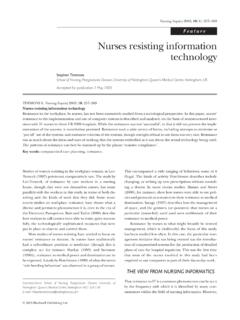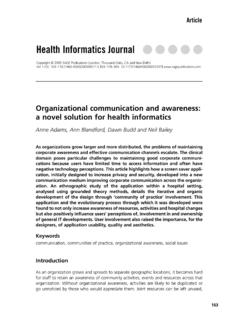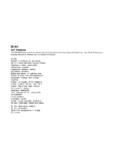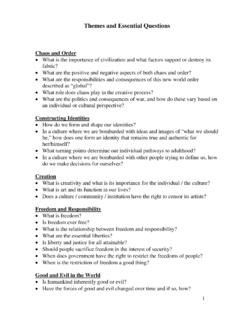Transcription of Medication errors in hospitals: a literature review of ...
1 REVIEWM edication errors in hospitals: a literature review of disruptions tonursing practice during Medication administrationCarolyn Hayes, Debra Jackson, Patricia M Davidson and Tamara PowerAims and purpose of this review was to explore what is knownabout interruptions and distractions on Medication administration in the contextof undergraduate nurse and errors during the process of Medication administrationcontinue to be a substantial patient safety issue in health care settings internation-ally. Interruptions to the Medication administration process have been identifiedas a leading cause of Medication error. literature recognises that some interrup-tions are unavoidable; therefore in an effort to reduce errors , it is essential under-stand how undergraduate nurses learn to manage interruptions to the medicationadministration , critical literature the electronic databases, of Medline, Scopus, PubMed andCINAHL, and recognised quality assessment guidelines, 19 articles met theinclusion criteria.
2 Search terms included: nurses, Medication incidents or errors ,interruptions, disruption, distractions and have responded to the impact of interruptions and distrac-tions on the Medication administration by attempting to eliminate them. Despitethe introduction of quality improvements, little is known about how nurses man-age interruptions and distractions during Medication administration or how theylearn to do so. A significant gap in the literature exists in relation to innovativesustainable strategies that assist undergraduate nurses to learn how to safely andconfidently manage interruptions in the clinical findings highlight the need for further exploration into theway nurses learn to manage interruptions and distractions during medicationadministration. This is essential given the critical relationship between interrup-tions and Medication error to clinical preparing nurses to safely fulfil the task ofmedication administration in the clinical environment, with increased confidencein the face of interruptions, could lead to a reduction in errors and concomitantimprovements to patient does this study contribute tothe wider global clinicalcommunity?
3 Provides insights into the lack ofknowledge regarding how nursescurrently manage interruptionsduring Medication administra-tion. Identifies the need for the devel-opment of sustainable pro-grammes that include highquality learning experiences thatteach interruption managementtechniques to undergraduatenurses in a safe environment. Identifies the need for furthersolution-focussed research intothe impacts of interruptions onerror interception rates. Highlights the need for researchinto the effects of interruptionson nonscheduled :Carolyn Hayes, RN, BHSc, Technical Officer, Faculty ofHealth, University of Technology Sydney, NSW;Debra Jackson,PhD, RN, Professor of Nursing, Faculty of Health, University ofTechnology Sydney, NSW;Patricia M Davidson, PhD, RN, FAAN,Professor, Dean, School of Nursing, Johns Hopkins University, Balti-more, MD;Tamara Power, PhD, RN, Lecturer, Faculty of Health,University of Technology Sydney, Broadway, NSW, AustraliaCorrespondence:Carolyn Hayes, Technical Officer, Faculty ofHealth, University of Technology Sydney, Building 10 level 7, 235 Jones Street, Broadway, NSW 2007, Australia.
4 Telephone:+61 02 9514 2015 John Wiley & Sons LtdJournal of Clinical Nursing, doi: words:disruption, distractions, interruptions, Medication errors , multitasking,nursesAccepted for publication: 8 June 2015 IntroductionMedication and intravenous fluid (IV) incidents and errorsare the second most reported clinical incident in Australianhealth care settings. Figures from NSW, Australia, revealed10,475 Medication and IV incidents and errors over a six-month period (Clinical Excellence Commission & Health2013). Similarly, Medication incidents and errors remain asignificant problem in North America, Canada and the UK(Kohnet ). An average of 450,000 preventablemedication errors are reported each year from the USA(Flanders & Clark 2010). The Australian Commission onSafety and Quality in Health Care developed a set of 10 National Safety and Quality Health Service Standardsaimed at improving the quality of care within the healthcare service (The Australian Commission on Safety andQuality in Health Care 2011).
5 Standard number 4addresses Medication safety and outlines the need for sys-tems to be implemented to ensure that the health careworkforce are competent when administering medications,to reduce Medication incidents and errors , improve safetyand quality care for to the Medication administration (MA) pro-cess have been identified as one of the leading causes ofmedication errors (Reid-Searlet ). These errorshave the potential to have long-term negative effects on thelife of a patient, their relatives and the administering nurse,and result in financial burdens on the health care system(Roughead & Semple 2009). The primary responsibility forthe majority of hospital-based MAs remains with thenursing staff (Paleseet , Reid-Searlet ).Combined with the inevitability of interruptions within theclinical environment (Flynnet ), the way in whichthe nursing staff learn to manage interruptions during MAis a key element in ensuring patient safety.
6 Consequently, aliterature review exploring the impact of interruptions anddistractions on MA was undertaken in the context ofundergraduate nurse education. literature addressing hownurses currently learn to manage interruptions and distrac-tions during MA was reviewed to identify existing gaps andencourage research into the identification of new strategiesthat may support this ongoing health care safety 20% of all MAs result in error (Runcimanet , Reid-Searl & Happell 2012). In addition toreported errors , between one and two errors per patient perday remain unreported (Reid-Searlet , Flynnet ). Financial and personal costs attached to these errorsinclude increased lengths of stay, readmissions, patientmortality, postdischarge disability and emotional distress ofthe patient, relatives and administering nurse (Roughead &Semple 2009, Chooet , Flynnet ).There are five identifiable phases within the process ofMA in which errors occur: prescription, transcription, dis-pensing, administering and monitoring patient condition/documenting (Chooet , Jenningset ).
7 Theadministration phase is particularly vulnerable to errors (Jenningset ). Simultaneous demands or interrup-tions during these complex processes, increases the likeli-hood of errors occurring (Chooet ).Between 16 and 40% of nurses time is engaged in MA(Potteret , Westbrooket ). Jenningset al.(2011), p. 1448) highlight the fact that MA does not occurin isolation from other work and found that rather thanconsuming a set portion of the nurses day, it was difficultto separate the impacts of MA from other tasks, and there-fore concluded that MA in fact constitute[s] the day . Withthis heavy emphasis on MA, the way interruptions to theprocess are managed impacts on nurses ability to deliversafe and effective patient-centred care (Hayeset ).AimThe purpose of this review was to explore what is knownabout interruptions and distractions on MA in the contextof undergraduate nurse review draws together and critically examines domi-nant and recurring themes existing in the literature in rela-tion to the impact of interruptions and distractions on MA,and strategies used by undergraduate nurses to manage 2015 John Wiley & Sons Ltd2 Journal of Clinical NursingC Hayeset It raises questions as to whether or not current strate-gies that aim to reduce or eliminate interruptions anddistractions are appropriate as standalone measures toreduce interruption related Medication errors in the clinicalenvironment.
8 To present a comprehensive background andadvance the understanding of this multifaceted yet commonproblem in nursing, and highlight gaps in current knowl-edge a critical review approach was both electronic and hand searching, a total of1854 articles were retrieved. Duplicated articles wereexcluded (n=126). Title review excluded literaturereviews, studies specific to multidisciplinary teams, medicalpractitioners or other health care professionals (n=1549).The remaining 179 studies were subject to abstract and/orfull text review . Nonprimary research, discursive studiesand those that were not specific to registered or undergrad-uate nurses or not related to interruptions or distractions, Medication incidents and/or errors during MA wererejected. Studies considered to be methodologically unsoundbased on the Critical Appraisal Skills Program (CASP)checklists were also excluded (Critical Appraisal Skills Pro-gramme 2013).
9 CASP guidelines were cross-referenced withstudies in search of clear aims, appropriate methodology,recruitment strategy, record of ethical considerations andrigorously analysed data with clear findings. If these guide-lines were not adequately addressed the studywas a result 160 studies were excluded, generating 19 studieswhich met the inclusion criteria (see Fig. 1). Analysis of theremaining articles was completed by the primary author,and validated by the entire author Articles identified via electronic and hand searching n = 1,854 Articles retained that meet all inclusion criteria n = 19 Articles excluded following abstract and full text review using quality appraisal tooln = 160 Articles excluded following title review n = 1,549 Articles excluded due to duplication n = 126 Number of articles remainingfollowing title reviewn = 179 Number of articles remainingn = 1,728following removal of duplicationsFigure 1 Retrieved articles.
10 2015 John Wiley & Sons LtdJournal of Clinical Nursing3 ReviewMedication errors : interruptions and distractionsSearch strategyThe literature search was conducted utilising the onlinedatabases: Medline, Scopus, PubMed, CINAHL and Googlescholar. In addition, the reference lists of retrieved articleswere hand searched. Keywords included nurses, medicationincidents or errors , interruptions, disruption, distractionsand criteriaElectronic literature searches were limited to English lan-guage, humans and articles published from Jan 2005 Dec2012. Suitability for inclusion in the review was evaluatedagainst clear inclusion and exclusion criteria (see Table 1).Included studies comprised peer-reviewed, research-basedarticles, where the domain was undergraduate nursing. Dueto the scarcity of literature examining undergraduatenurses responses to interruptions during MA, the searchwas broadened to include both registered and undergradu-ate nurses.








